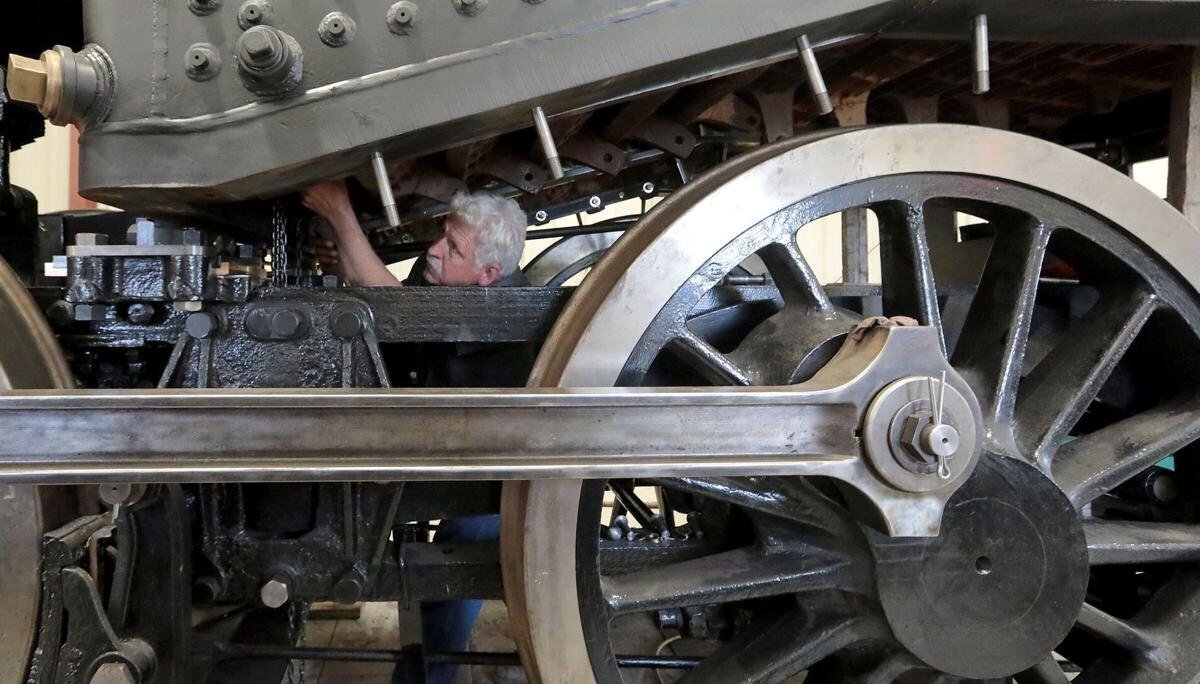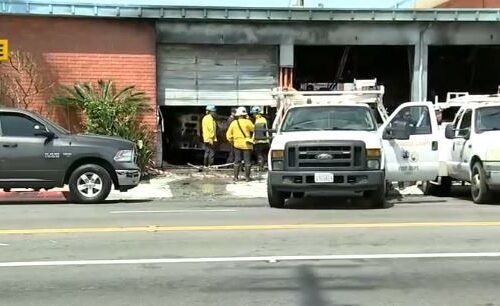Finish in sight for complete restoration of 1385 locomotive for Mid-Continent Railway Museum

Steve Roudebush works on the underside of a 1907 steam locomotive at SPEC Machine north of Middleton on Thursday.
By Barry Adams
Click here for updates on this story
TOWN of SPRINGFIELD, WISCONSIN (madison.com/Wisconsin State Journal) — A new driveway is getting closer to reality for Steve Roudebush.
The 200-yard stretch of narrow asphalt is pocked with potholes and less than a smooth ride to his family’s farm, which shares space with Roudebush’s machine shop.
The delay hasn’t been about money, supplies or finding a contractor.
Instead, Roudebush, owner of SPEC Machine, is waiting until he finishes the longest and largest job in his company’s history.
When the project finally leaves his shop on a 13-axle trailer, it will weigh about 180,000 pounds and likely do further damage to his already challenged driveway.
That’s why Roudebush is waiting, while at the same time putting in long hours to complete the $2 million restoration started in late 2013 of a historic steam engine for the Mid-Continent Railway Museum in North Freedom.
“We’re coming to an end,” Roudebush said last week as he stood near the front of the engine. “Hopefully in a year or so, it will be done and out of here.”
About 75% of the locomotive remains original but has undergone extensive restoration. The remaining 25% consists of new parts built to the exact specifications from when it was constructed in 1907 at American Locomotive Co.’s Schenectady Works in New York.
The goal is to get the steam locomotive back on the tracks of the museum, which has 3.5 miles of rail winding through central Sauk County, eight miles west of Baraboo.
Museum officials and Roudebush thought the project would take about 14 months and be focused primarily on the locomotive’s running gear and boiler. But once they got into the project, it didn’t take long to realize a full restoration and rebuild was necessary.
It took a St. Louis company two years just to build a new boiler, while Roudebush and his son, Tyler, have machined scores of new parts, including hundreds of bolts. The locomotive arrived in pieces, but to accommodate the project the shop was rearranged, a 14-foot-wide, 16-foot-high door to the shop was added and 80 feet of train track constructed. In 2017, an addition was put on to the west side of the shop to give the locomotive its own private space.
“I don’t think anyone had a true feeling of the scope and size of this project,” said Jeff Huttenburg, who lives near the shop and has been involved with the museum for the past eight years. “When we started out it was just to fix a few things here and there.”
A brief history The 1385 was a workhorse for the Chicago & North Western Railroad for nearly five decades but was retired in 1956.
Mid-Continent members in 1961 scraped together $2,600 to buy the locomotive, and from 1963 to 1998 it was used to pull cars on the museum’s tracks. In the mid-1980s, it pulled the Great Circus Train for three straight summers from Baraboo to Milwaukee and back, and in the 1990s made trips on the mainline to Brodhead, Mazomanie and Wausau before being taken out of service in 1998 for what they thought would be $125,000 in boiler repairs.
A closer inspection revealed the engine, which is on the state and national registers of historic places, needed much more work. The project was initially stalled by fundraising challenges, the recession and a flood at the museum in 2008 that caused extensive damage and closed the museum for the summer.
The Wagner Foundation, however, stepped in with an initial $250,000 matching grant and has continued to add more funds to the project, about 75% of which is funded by the foundation created by Bobbie Wagner and her now-late husband, Dick, founders of Wag-Aero, an aviation parts and delivery company.
The Wagner Foundation also helped fund the $677,000 reconstruction of a bridge over the Baraboo River that was severely damaged during the 2008 flood. That project has created longer runs for trains at the museum that specializes in railroad equipment from between 1885 and 1915.
In addition, the museum has just completed work on a 2,400-square-foot storage facility that will be used to hold excess parts from the 1385 and other locomotives and train cars.
“Your opportunity to rebuild an engine like this is pretty unique,” said Huttenburg, a retired attorney. “But everybody up at the museum is just really interested in getting this thing back.”
Then, a pandemic When the boiler arrived in September 2019, the locomotive was rolled out of its quarters so a 100-ton crane could lift the boiler into place. That turned out to be the last large public event as COVID-19 hit six months later.
But despite the lockdowns, the progress on the locomotive’s restoration has been steady over the past two years and is now entering a more aggressive phase as Steve Roudebush said he is now dedicating more of his time to the project and putting some of his other jobs on the back burner.
The boiler has been fitted to the chassis and mounted to the saddles with custom bolts and fittings. It includes on the rear of the boiler steel plates that allow the boiler to slide up to three quarters of an inch as the boiler expands when it is heated. Rocker grates, used to dump ash and fire out of the fire box, were installed last week, while throttle valves, exhaust nozzles, pistons and air compressors are either finished or more than halfway toward completion.
Installing the ash pan is one of the next tasks on the never-ending list of tasks.
“There’s nothing on this that we regret,” Roudebush said. “If we weren’t uncomfortable (with a job) we went back and resolved the issue. That’s how we do all of our work around here.”
Grit and labor When we arrived at the shop on Thursday morning, Roudebush was underneath the locomotive installing one of the last rocker grates, which need to be operational in heat that can reach up to 1,600 degrees. His son Tyler, 31, was in the firebox using a chain to help hoist the 140-pound grate into position. Tyler, a volunteer firefighter in Waunakee, had accessed the space by crawling through a 2-foot opening, normally used to pass coal or wood through.
“We’ll train getting through tight spaces,” Tyler said of his firefighting work. “It’s all about manipulating your body and learning how to move it the right way. It’s amazing how small of a hole you can fit through.”
For Steve Roudebush, the last year has been filled with milestones. He became a grandfather for the first time, built his wife a she shed, put the wraps early on a fall harvest of 220 acres of corn and soybeans, purchased a more than 100-year-old steam engine that needs restoration and in October for his 58th birthday, hunted and shot his first bull elk in the mountain terrain of southwestern Colorado.
His group started the hunt at 9,000 feet of elevation, and he found success just before dark. That meant working in the dark to skin and quarter the elk and pack it out on horses. They returned to their camp at 4 a.m. the next day. Roudebush called it the toughest thing he’s ever done in his life, but was asked how it compared to his eight years of detailed work on the 1385.
“They’re both tough in different ways,” Roudebush said. “This (the 1385) is more emotionally challenging.”
Please note: This content carries a strict local market embargo. If you share the same market as the contributor of this article, you may not use it on any platform.


